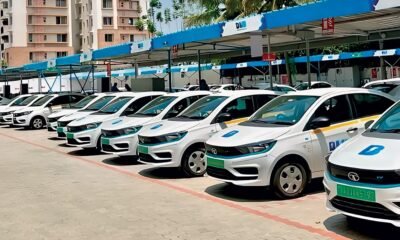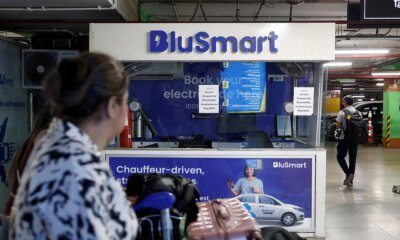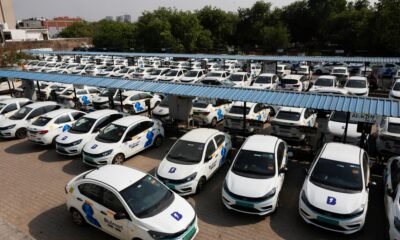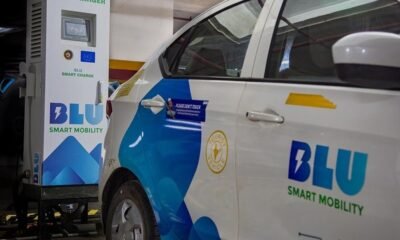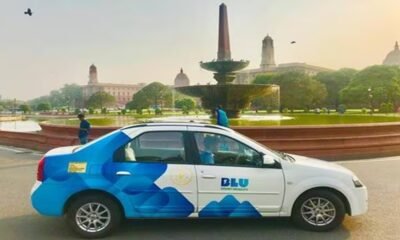Ride & Mobility
BluSmart: Wallet worries for customers as EV ride-hailing service screeches to a sudden halt
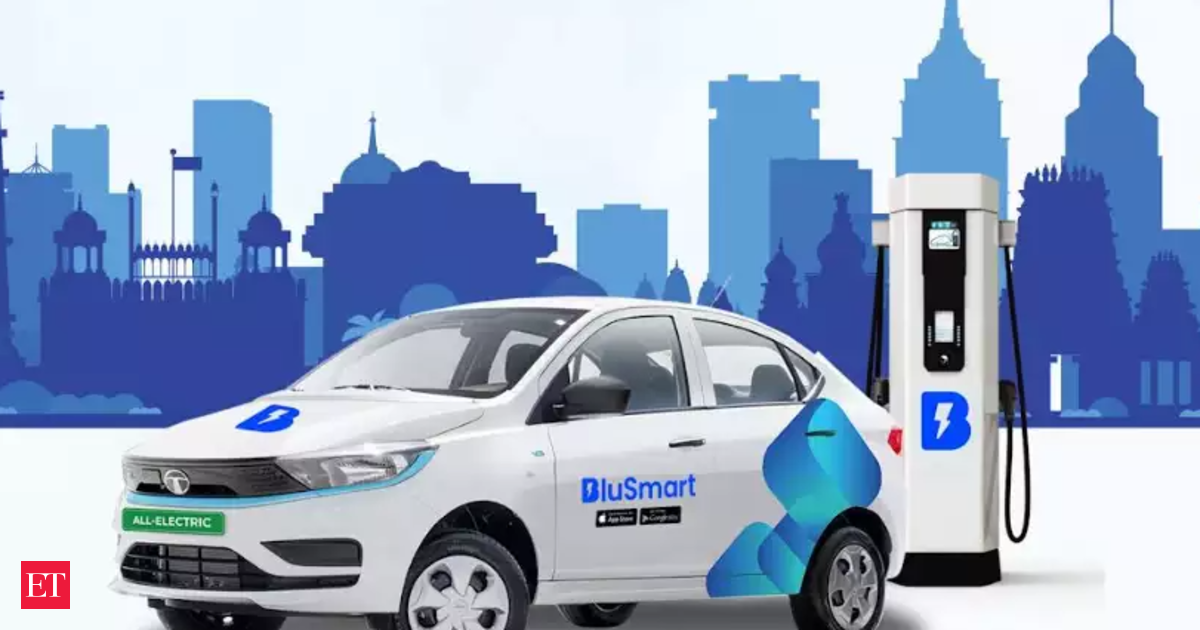
With a fleet of over 8,500 electric vehicles and more than 5,800 charging stations, BluSmart established itself as a significant player in the urban commute sector across Delhi-NCR, Mumbai, and Bengaluru in a very short time, supported by a network of 10,000 active drivers. The electric vehicle ride-hailing service seemed to have gone offline now, leaving many regular users in a lurch and its vehicles largely off the streets, ToI reported on April 17.
The service disruption came in the wake of an interim order from Sebi on Tuesday, which alleged that Anmol and Puneet Singh Jaggi, the promoters, had redirected funds obtained through loans intended for purchasing electric vehicles for BluSmart, using a portion of the money to buy a luxury apartment in Gurugram.
The order also highlighted other governance issues, such as transactions with related entities and the misuse of corporate funds. Consequently, both promoters were barred from accessing the securities market and from holding director or key managerial positions at Gensol until further notice. Additionally, Gensol was instructed to suspend its proposed stock split.
As Gensol faces increasing scrutiny, concerns are mounting regarding BluSmart’s financial viability and operational stability. Although the EV platform is legally a separate entity, its close ties to its promoters have sparked speculation about its future, particularly following reports of potential partnerships with Uber to become a fleet supplier—an option that analysts now suggest may be challenging in light of Sebi’s recent actions.
The growth of BluSmart since its inception in 2019 has been remarkable. The platform found its footing in a market previously dominated by established services like Ola and Uber, providing an eco-friendly alternative with fixed pricing, dependable rides, and environmentally friendly vehicles. For numerous passengers, BluSmart became an essential part of their daily commute.The abrupt halt in services followed a decision by market regulator Sebi, which prohibited the promoters of Gensol Engineering—the parent company of BluSmart—from participating in the securities market due to accusations of fund misallocation and governance issues.
Users’ tales
Users across major cities including Delhi, Gurugram, Noida, Bengaluru, and Mumbai began reporting difficulties with the BluSmart app on Wednesday, stating that they were unable to make bookings. In many instances, neither the date nor time slots would load, preventing any bookings from being completed.
Some drivers shared with TOI that they managed to fulfill only pre-scheduled rides, while others received notifications from the company advising them not to come to work on Thursday. By late evening, there was still no official communication from BluSmart, and when approached, a company representative refrained from commenting.
The unexpected disruption caused significant inconvenience for many users. “I couldn’t secure a ride at 9 am because the app wouldn’t load any slots. I later found out my colleagues were experiencing the same problem,” remarked Priyanshi Saha, a professional from Cyber Hub living in Sector 56, Gurugram. “This was the only service I relied on that had fixed fares and an eco-friendly approach.”
Another user, Jagriti Kumar, who works in Udyog Vihar, expressed her discontent, stating that BluSmart was her sole dependable option for commuting. “It was consistent, never cancelled unexpectedly, and charged between Rs 400-450 every time. Now, I’ll have to deal with fluctuating prices and unpredictable drivers on other services.”
Wallet worries for commuters: What to do to get your balance back
Several loyal users voiced their concerns about the funds stuck in their BluSmart app wallets. “I have Rs 1,700 in my wallet, and there’s been no word regarding refunds,” mentioned Abhijeet Ghosh, a resident of central Delhi. Others like Kanika Tomar (with unspent wallet balance at Rs 2,500), and Ashish Malik (Rs 760), shared similar worries.
“The lack of communication from the company is quite unsettling,” Kanika added.**
Consumer lawyer Aditya Parolia has advised users to document their wallet balances with screenshots and to promptly reach out to the company for refunds. “This documentation will assist them in establishing claims if a third-party administrator takes over. The situation raises broader issues regarding startup governance and consumer accountability,” he stated.
BluSmart: Short history of the well-liked service
BluSmart was introduced as a zero-emission ride service that operated under a fleet-ownership model. Unlike competitors like Ola and Uber, where drivers own or lease their vehicles, BluSmart owned its electric cars and employed drivers on a fixed salary with additional incentives.
Customers enjoyed clean, quiet rides, punctual pickups, and consistent pricing, which helped the platform build a loyal customer base.
“The drivers were always courteous. There was no noise, no bargaining, and no last-minute cancellations. I often conversed with the drivers, most of whom seemed content with their jobs,” reflected Ghosh, who used BluSmart for nearly two years.
Rachit Gupta, who regularly traveled between Delhi and Gurugram, noted that the well-maintained fleet and timely service kept him engaged with the service. “It was the best alternative to the chaos of Ola and Uber,” he recounted.
BluSmart’s failure: The biggest losers
For drivers, the current disruption poses significant challenges. Since BluSmart owns the vehicles, many drivers are uncertain about their future. “We were informed that a vendor would inspect our cars tomorrow and that we should not report to work,” Dileep, a driver waiting at IGI’s T3 terminal, explained to ToI. “If the company collapses, we can’t transition to other platforms because we don’t own the cars,” he said.
Another driver, Arun from Faridabad, shared that he usually earned between Rs 3,200-4,300 for 10-12 hour shifts, including daily bonuses. “It was a good arrangement. I didn’t receive any bookings today, and I’m unsure what comes next,” he told the newspaper.
**The company subsequently communicated that customers’ balance would be refunded within 90 days in case the service doesn’t resume by that time.
Ride & Mobility
Leading Tech Firms Accelerate Development of Consumer-Focused Robotaxi Services

Major technology and mobility companies are advancing their initiatives in the robotaxi sector, with a focus on delivering driverless vehicle services to consumers. These efforts are part of a broader industry shift toward autonomous transportation, driven by advances in artificial intelligence and vehicle automation.
Tesla Pioneers Fully Autonomous Ride-Sharing Platform
Tesla has been at the forefront of the robotaxi movement, with CEO Elon Musk outlining a vision for a fully autonomous ride-hailing service. The company has been testing its Full Self-Driving (FSD) software in controlled environments and is preparing for a phased rollout of its robotaxi fleet. Tesla’s approach emphasizes over-the-air software updates and a vehicle fleet that can transition from personal ownership to shared mobility services.
Alphabet Expands Waymo’s Urban Reach
Alphabet’s autonomous driving division, Waymo, continues to expand the geographic footprint of its robotaxi service. The company has been testing its autonomous vehicles in multiple cities and is working on integrating the service into a broader mobility network. Waymo’s strategy focuses on high-density urban areas, where the demand for ride-sharing is strongest. The service is designed to operate with minimal human intervention, relying on advanced sensor systems and AI decision-making.
Baidu’s Apollo Launches Commercial Robotaxi Pilot
Baidu’s Apollo platform has launched a commercial robotaxi pilot, offering autonomous rides to the public in select cities. The service is part of Baidu’s broader smart transportation initiative and is supported by partnerships with local governments and automotive manufacturers. Apollo’s robotaxis are equipped with the company’s proprietary AI and sensor technology, which enables real-time navigation and passenger safety monitoring.
Uber Integrates Autonomous Vehicles into Ride Network
Uber is integrating autonomous vehicles into its existing ride-hailing platform, aiming to reduce operational costs and improve service efficiency. The company has been conducting trials with self-driving vehicles and is working on a model where drivers and autonomous vehicles coexist within the same app. Uber’s long-term goal is to transition to a fully autonomous fleet, with a focus on maintaining customer experience and safety standards.
Amazon Explores Last-Mile Delivery and Ride-Sharing Synergies
Amazon is exploring the use of autonomous vehicles not only for delivery services but also for ride-sharing. The company has been testing small, electric autonomous vehicles for last-mile delivery and is now looking to expand into the passenger transportation space. Amazon’s approach leverages its existing logistics infrastructure and AI capabilities to create a seamless mobility experience.
Industry Momentum Reflects Confidence in Autonomous Future
The collective efforts of these companies signal growing confidence in the commercial viability of robotaxi services. While challenges such as regulatory approval, public acceptance, and technical refinement remain, the industry is moving toward a future where autonomous vehicles play a central role in urban transportation. The integration of AI, cloud computing, and vehicle automation is enabling a new era of mobility, with major tech firms leading the charge.
Ride & Mobility
Police test ride-hailing robot to patrol Changi Airport T4 , Singapore News
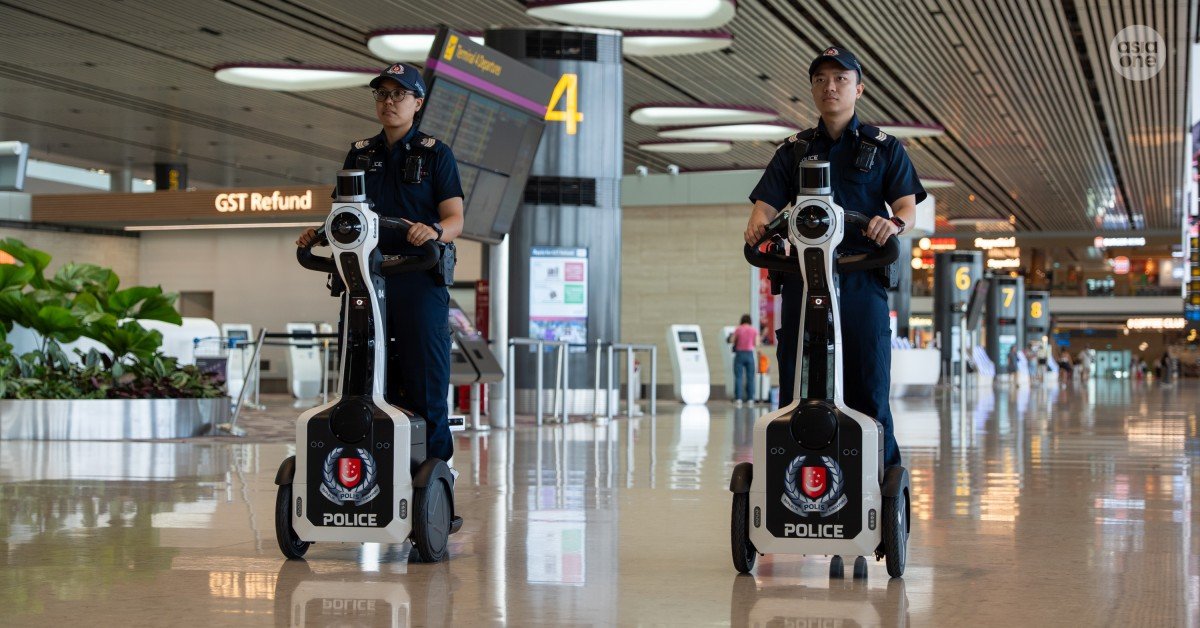
The Singapore Police Force’s Airport Police Division (APD) and Home Team Science and Technology Agency (HTX) have been piloting a new police patrol robot named Gibson since early July.
This indoor robot, which was built to enhance police presence and improve officers’ mobility, can also be used as a means of transport.
During the demonstration to the media on Wednesday (July 16), Gibson operated within Changi Airport Terminal 4 in its dual-mode operation — autonomous and ride.
The autonomous mode compromises of in-depth cameras, 3D LiDAR (Light Detection and Ranging) cameras and Sonar (Sound Navigation and Ranging) techniques that allow Gibson to determine its location, safely navigate the indoor environment and avoid collisions.
This indoor robot is also equipped with a “safety bubble” feature, which functions as a proximity detector. This means it can stop and sound a horn when it detects that someone is too close or obstructing its path.
On the other hand, the ride mode allows the robot to travel to an officer’s location autonomously through a ride-hailing function.
This function is developed in-house by HTX, and it is especially critical for APD’s Ground Response Force officers as it frees them to focus on incident response while enhancing mobility and operational readiness within the airport.
“Its autonomous mode will allow officers not to worry about having where to park Gibson, where it can continue to patrol in the airport without having to return to its designated parking lot,” said Superintendent of Police Patrick Pang, an operations officer for planning and readiness from APD.
He also mentioned that the ride mode is designed to “allow officers to summon for Gibson without having to manually search for one”.
Officers riding it will be able to travel large indoor areas, thus improving their incident response time.
Human-robot collaboration
“Gibson was developed as part of our ongoing efforts in advancing human-robot collaboration where Home Team officers can team up with robotics systems to carry out patrol missions and to respond to incidents collaboratively,” said Seah Qi Yan, an engineer from HTX Robotics, Automation and Unmanned Systems.
Gibson was developed through a collaboration with the A*STAR Institute for Infocomm Research.
HTX plans to move beyond traditional patrol robots that work on their own, aiming to build smarter, more connected robots that can react to their surroundings and take input from Home Team officers.
Gibson is not the first robot that has been used by the police in Changi Airport, but this is the first rideable one. It is not known when it will become operational.
When AsiaOne was invited to test out Gibson, we found the ride to be unexpectedly smooth. Although there were some shaky moments when approaching a turn, the robot handled it well.
[[nid:719449]]
Ride & Mobility
2-in-1 airport police robot on trial can patrol and serve as PMD with ride-hailing feature
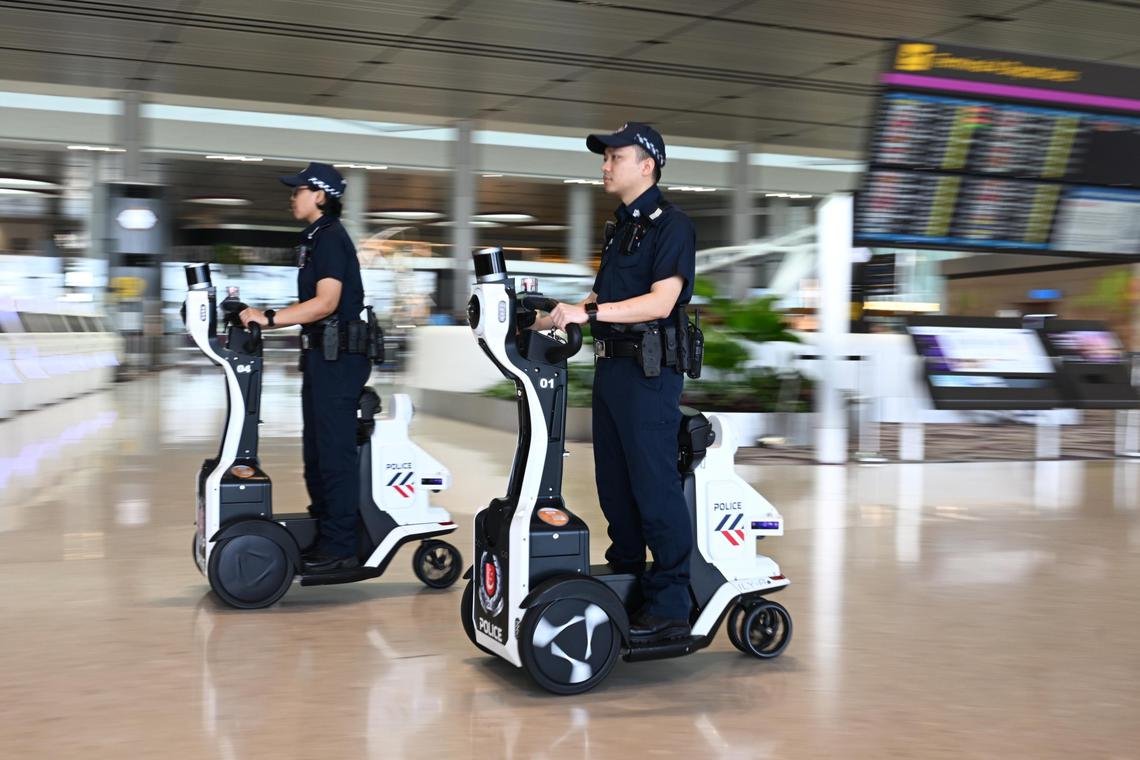
SINGAPORE – A police patrol robot that doubles as a personal mobility device (PMD) for officers is being trialled at Changi Airport Terminal 4.
The autonomous robot, called Gibson, is outfitted with multiple cameras and sensors to help it avoid obstacles and people. Officers can also use it for transportation, to cover long distances at the airport quickly.
The Home Team Science and Technology Agency (HTX) developed Gibson in collaboration with the A*Star Institute for Infocomm Research. The trial began in early July.
“Gibson was inspired by the concept of creating a buddy robot for our officers,” said HTX engineer Seah Qi Yan from the Robotics, Automation and Unmanned Systems Centre of Expertise. “They can use it as a PMD in their operations and transform it into an autonomous robot when not in use.”
Gibson was developed to advance human-robot collaborations in the Home Team, Ms Seah added.
Its ride-hailing function is a key feature that was developed in-house. Using their phone or tablet to access the robotics platform, officers can call for an available robot to meet them at a nearby pickup point.
While travelling aboard Gibson, they can select the autonomous function to get them to their destination as they tend to other matters, such as reviewing incidents on their devices. Alternatively, officers may choose to drive it manually by using a physical key.
Two of the robots were shown to the media on July 16 at Terminal 4.
Each robot has a battery life of about four hours, and has safety features such as automatically stopping if someone attempts to get on it while it is moving. Attempts to block Gibson intentionally as it is patrolling will cause it to sound a horn.
Named after inventor Arthur Hugo Cecil Gibson, who made the first motorised scooter in the early 1900s, it is the second type of police robot to be used at the airport.
The first police patrol robots were introduced at the airport in April 2023, after more than five years of trials and smaller-scale roll-outs.
Superintendent of Police Patrick Pang, an operations officer for planning and readiness from the Airport Police Division, said Gibson will complement existing police patrols and enhance the police presence at the airport.
He said: “The ride-hailing function makes it convenient for officers to summon Gibson without having to manually search for one.
“And with the autonomous mode, our officers do not have to worry about where to park, as it can resume its patrols without returning to a designated parking lot.”
-

 Brand Stories11 hours ago
Brand Stories11 hours agoBloom Hotels: A Modern Vision of Hospitality Redefining Travel
-

 Brand Stories11 hours ago
Brand Stories11 hours agoHow Olive Group of Hotels Is Redefining Wellness Travel in India—And Why the World Is Watching
-

 Destinations & Things To Do1 day ago
Destinations & Things To Do1 day agoUntouched Destinations: Stunning Hidden Gems You Must Visit
-

 AI in Travel1 day ago
AI in Travel1 day agoAI Travel Revolution: Must-Have Guide to the Best Experience
-

 Brand Stories2 weeks ago
Brand Stories2 weeks agoVoice AI Startup ElevenLabs Plans to Add Hubs Around the World
-

 Brand Stories1 week ago
Brand Stories1 week agoHow Elon Musk’s rogue Grok chatbot became a cautionary AI tale
-

 Asia Travel Pulse2 weeks ago
Asia Travel Pulse2 weeks agoLooking For Adventure In Asia? Here Are 7 Epic Destinations You Need To Experience At Least Once – Zee News
-

 AI in Travel2 weeks ago
AI in Travel2 weeks ago‘Will AI take my job?’ A trip to a Beijing fortune-telling bar to see what lies ahead | China
-

 Brand Stories2 weeks ago
Brand Stories2 weeks agoChatGPT — the last of the great romantics
-

 The Travel Revolution of Our Era1 month ago
The Travel Revolution of Our Era1 month agoCheQin.ai Redefines Hotel Booking with Zero-Commission Model

